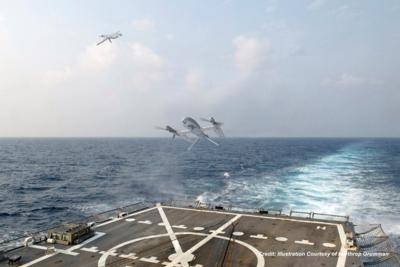Sun, Jul 30, 2023
Northrop Grumman Contracted for Next-Gen Seaborne VTOL UAV Beyond Current Market Capability
The Defense Advanced Research Project Agency’s (DARPA) Tactical Technology Office has contracted with Northrop Grumman to design an autonomous VTOL aircraft system for use in US Navy ships while underway, slated to carry a 60-lb payload for more than 20 hours of flight time.

The contract illustrates the relatively empty field in that particular tactical niche, one that has been addressed through more traditionally designed, helicopter-like UAVs abroad. Naval aviation is often a difficult realm of design and operations, combining a moving takeoff and landing platform with the fueling constraints of operations beyond convenient, abundant supply lines - and that's leaving out the harsh impacts of landing in rough seas. While General Atomics has made some headway in adapting its existing MQ-9 platform to oceanic operations, their mods basically amount to a STOL kit for improved takeoff performance on carriers. The Schiebel Camcopter S-100 has seen increasing use overseas, but its wankel engine limits endurance to a bit more than 6 hours with a 75-lb payload, making fall short of the 20-hour contract requirement.
Grumman hopes its AdvaNced airCraft Infrastructure-Less Launch And RecoverY (or, in typical MIL fashion, "ANCILLARY") demonstrator will fit the bill as a "cost-efficient, multiple-mission capable vehicle built on an agile platform that is runway independent." It believes the Ancillary platform will be "capable of carrying a large 60-pound sensor payload with greater endurance of 20 hours’ time on station and mission radius range of 100 nautical miles", while noting that such specs exceed current systems. Additional goals include the ability to land in adverse weather conditions. Its mission will be the usual blend of ISR, targeting, and expeditionary support one would expect of a little whirlybird at sea, as they've all been since the original U-Boat rotor kites took to the skies in WWII. Of course, the new equipment will be far more effective, but it's interesting to note that the tactical lineage is there - ships want a pair of eyes they can launch themselves.
Northrop Grumman VP of research and advanced design Tim Frei made sure to weigh in on the situation with a generically encouraging pull quote, saying the firm will work with DARPA "to significantly enhance how future autonomous vertical lift aircraft will operate at sea and ashore. The ANCILLARY program enables us to combine our digital engineering expertise with extensive knowledge and insights from past successes in developing and operating uncrewed vertical lift aircraft for the U.S. Navy.”
More News
Terminal Radar Service Area Airspace surrounding designated airports wherein ATC provides radar vectoring, sequencing, and separation on a full-time basis for all IFR and participa>[...]
Very High Frequency (VHF) The frequency band between 30 and 300 MHz. Portions of this band, 108 to 118 MHz, are used for certain NAVAIDs; 118 to 136 MHz are used for civil air/grou>[...]
“From approximately November 2021 through January 2022, Britton-Harr, acting on behalf of AeroVanti, entered into lease-purchase agreements for five Piaggio-manufactured airc>[...]
Also: Virtual FLRAA Prototype, IFR-Capable Autonomous A/C, NS-32 Crew, Golden Dome Missile Defense Bombardier announced that the first production Global 8000 successfully completed>[...]
Aero Linx: The 1-26 Association (Schweizer) The Association’s goal is to foster the helpfulness, the camaraderie, and the opportunity for head-to-head competition that is fou>[...]
 ANN's Daily Aero-Term (05.29.25): Terminal Radar Service Area
ANN's Daily Aero-Term (05.29.25): Terminal Radar Service Area ANN's Daily Aero-Term (05.30.25): Very High Frequency (VHF)
ANN's Daily Aero-Term (05.30.25): Very High Frequency (VHF) Aero-News: Quote of the Day (05.30.25)
Aero-News: Quote of the Day (05.30.25) Airborne 05.23.25: Global 8000, Qatar B747 Accepted, Aviation Merit Badge
Airborne 05.23.25: Global 8000, Qatar B747 Accepted, Aviation Merit Badge ANN's Daily Aero-Linx (05.30.25)
ANN's Daily Aero-Linx (05.30.25)



